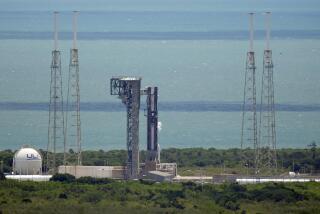Mars Probe Still Silent; Outlook Bleak
- Share via
Jet Propulsion Laboratory scientists controlling the Mars Polar Lander failed early this morning in what was considered the last, best hope for contacting the spacecraft.
Beginning at 12:20 a.m. today, flight controllers tried to establish contact with the lander’s UHF antenna using a signal relayed through the orbiting Mars Global Explorer. Previous attempts have focused on direct communication using the lander’s medium-gain antenna, and controllers hoped the new approach would be successful.
But this try--like the six others before it--failed, and the future of the spacecraft looks bleak. “We’re pretty much reaching the point where we’ve used up our final silver bullets,” said project manager Richard Cook. “Once we are done with [today’s attempts], we are really at the point of diminishing returns.”
He added that flight controllers will probably shut down attempts for a week or so to evaluate their position and consider alternatives.
Attempts Monday to contact the two tiny probes jettisoned by the lander that were supposed to slam into Mars’ surface last Friday were also unsuccessful.
The team controlling the probes had apparently exhausted most of the possibilities for contacting the $29.2-million, softball-sized Deep Space 2 instruments, according to NASA spokesmen.
As for the lander, the team has made seven attempts to contact it since it was scheduled to touch down just after noon Friday. All have met with silence.
The team had hoped the lander might have set down on the slope of a crater or in some other location that has limited its ability to find Earth in the sky above it. In such a scenario, its signal could still theoretically be picked up.
The repeated failures to contact it, combined with the failure to communicate with the probes, however, suggests that the craft may have suffered some cataclysmic event, perhaps during the separation of the probes from the lander.
Flight controllers can communicate with the lander only during brief “windows,” when the south pole of Mars, where the lander was scheduled to set down, is in direct line of sight with NASA’s antennas on Earth.
More to Read
Sign up for Essential California
The most important California stories and recommendations in your inbox every morning.
You may occasionally receive promotional content from the Los Angeles Times.













